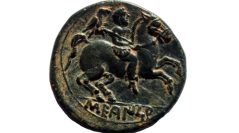

 Anthropozoologica
57 (5) - Pages 141-155
Anthropozoologica
57 (5) - Pages 141-155It has been generally acknowledged that falconry was unknown in Antiquity until it was imported in the 5th century AD by Germanic tribes into the lands of the Roman Empire. However, this theory contrasts with a 1st century AD epigram by Martial that depicts a hawk kept in captivity that regrets hunting for a fowler, a concept that can be perfectly understood as falconry. Due to a lack of knowledge of Iberian iconography and the absence of other early sources that attest to the existence of hawking in Antiquity, historians of hunting have interpreted Martial’s epigram in diverse ways to avoid accepting that the poet was familiar with falconry. However, a careful look at Iberian figurative arts between the 3rd and 2nd centuries BC reveals that Iberians depicted scenes perfectly coherent with falconry. Furthermore, some of these images were created in the region around Bilbilis where Martial was born, grew up and retired. Thus, we can conclude that it is highly likely that Martial was describing falconry in his epigram due to his knowledge of the sport in his native Hispania. Iberians seem to have practiced falconry since at least the 3rd century BC. This constituted an exception in the ancient world, since there is no evidence to prove that falconry was known in Middle Eastern, Greek or Roman civilizations.
Hunting, ancient poetry, ancient art, Iberian art, Iberian pottery, numismatics.